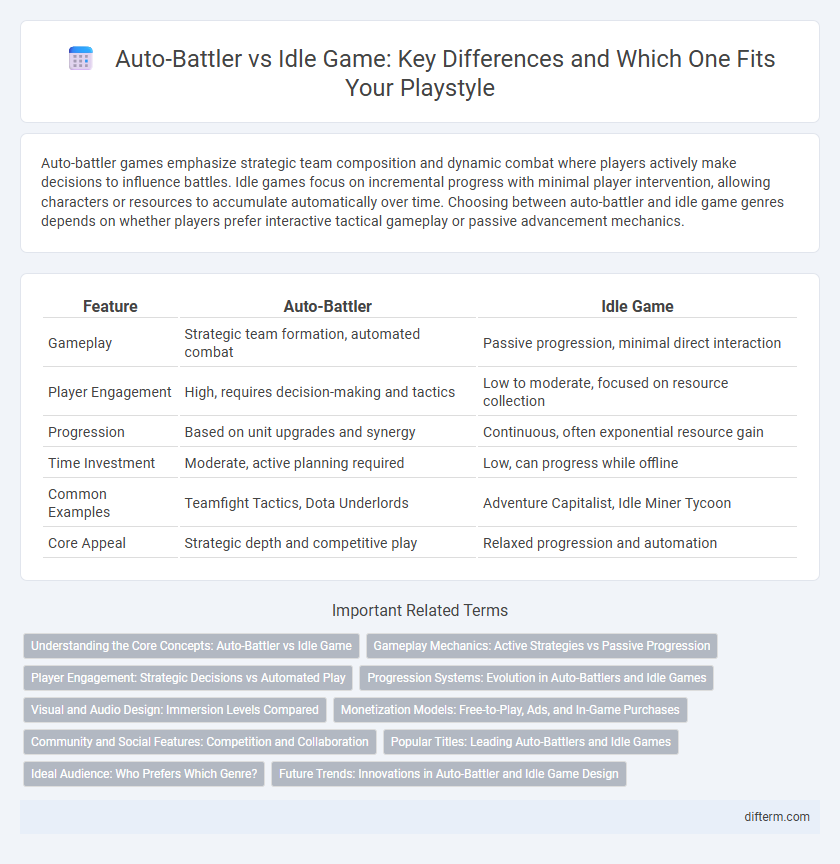Auto-battler games emphasize strategic team composition and dynamic combat where players actively make decisions to influence battles. Idle games focus on incremental progress with minimal player intervention, allowing characters or resources to accumulate automatically over time. Choosing between auto-battler and idle game genres depends on whether players prefer interactive tactical gameplay or passive advancement mechanics.
Table of Comparison
| Feature | Auto-Battler | Idle Game |
|---|---|---|
| Gameplay | Strategic team formation, automated combat | Passive progression, minimal direct interaction |
| Player Engagement | High, requires decision-making and tactics | Low to moderate, focused on resource collection |
| Progression | Based on unit upgrades and synergy | Continuous, often exponential resource gain |
| Time Investment | Moderate, active planning required | Low, can progress while offline |
| Common Examples | Teamfight Tactics, Dota Underlords | Adventure Capitalist, Idle Miner Tycoon |
| Core Appeal | Strategic depth and competitive play | Relaxed progression and automation |
Understanding the Core Concepts: Auto-Battler vs Idle Game
Auto-battler games center on strategic team composition and automated combat sequences, requiring players to optimize unit synergies and positioning to outlast opponents. Idle games emphasize passive progression through resource accumulation and incremental upgrades, allowing gameplay to advance without constant player input. Understanding these core differences highlights the active decision-making focus of auto-battlers versus the hands-off mechanic characteristic of idle games.
Gameplay Mechanics: Active Strategies vs Passive Progression
Auto-Battlers emphasize active strategies where players continuously manage unit placement, synergies, and timing to influence battles dynamically. Idle games prioritize passive progression, allowing players to accumulate resources and advancements automatically with minimal interaction. This key difference shapes player engagement by demanding strategic input in auto-battlers versus encouraging long-term growth through incremental upgrades in idle games.
Player Engagement: Strategic Decisions vs Automated Play
Auto-battler games demand active player engagement through strategic decisions, such as unit placement and resource management, enhancing cognitive involvement and game depth. Idle games emphasize automated play, allowing players to passively progress with minimal input, catering to casual audiences seeking low-effort entertainment. The contrast in gameplay mechanics shapes distinct player experiences, where auto-battlers prioritize tactical thinking and idle games focus on convenience and relaxation.
Progression Systems: Evolution in Auto-Battlers and Idle Games
Auto-battlers feature complex progression systems based on strategic layer upgrades, unit synergies, and tiered character evolutions that require player decision-making to optimize performance. Idle games utilize automated, incremental progression with exponential growth mechanics, allowing continuous resource accumulation and periodic resets to enhance efficiency and unlock new content. Both genres emphasize evolving player power, but auto-battlers demand active tactical input while idle games prioritize passive growth loops and scalability.
Visual and Audio Design: Immersion Levels Compared
Auto-Battler games feature dynamic visual effects and strategic animations that heighten player engagement and create a vivid sense of battlefield action, while their audio design includes thematic soundtracks and impactful battle sounds that enhance immersion. In contrast, Idle Games often employ minimalist visual elements and repetitive animations to emphasize passive gameplay, complemented by soothing or subtle ambient music that maintains a relaxed atmosphere without overstimulation. The immersive experience in Auto-Battlers is driven by sensory intensity and active feedback, whereas Idle Games rely on calm visual and audio cues to foster a low-pressure environment.
Monetization Models: Free-to-Play, Ads, and In-Game Purchases
Auto-battler games typically monetize through a blend of free-to-play access with in-game purchases that enhance strategy and unlock premium units, often supplemented by optional ads for additional rewards. Idle games rely heavily on ad-based monetization, offering players incentives to watch ads for resource boosts, while also integrating microtransactions that expedite progression or unlock exclusive content. Both genres capitalize on a hybrid approach, balancing user engagement and revenue generation through strategic placement of ads and diverse in-game purchase options.
Community and Social Features: Competition and Collaboration
Auto-battler games foster dynamic competition through ranked ladders and seasonal tournaments, encouraging players to refine strategies and engage in real-time matches. Idle games emphasize collaborative social features like guilds and co-op events, enabling players to share resources and progress collectively over time. Both genres build vibrant communities but differ in interaction intensity, with auto-battlers focusing on direct competition and idle games on sustained cooperative play.
Popular Titles: Leading Auto-Battlers and Idle Games
Auto-battler games like Teamfight Tactics, Dota Underlords, and Auto Chess dominate the genre with strategic gameplay requiring player decisions between rounds. Idle games such as Adventure Capitalist, Cookie Clicker, and Idle Heroes excel by offering continuous progression with minimal input, appealing to casual players seeking long-term rewards. Both genres retain large, dedicated communities driven by frequent updates and competitive leaderboards.
Ideal Audience: Who Prefers Which Genre?
Auto-battlers attract strategic gamers who enjoy making tactical decisions and adjusting team compositions during battles, appealing to players who value active engagement and skill-based challenges. Idle games cater to casual players seeking low-effort progression and relaxation through automated gameplay that requires minimal input. Competitive gamers typically favor auto-battlers for their complexity, while those looking for stress-free, incremental rewards prefer idle games.
Future Trends: Innovations in Auto-Battler and Idle Game Design
Auto-battler games are evolving with AI-driven tactics and dynamic meta-shifts that enhance strategic depth and player engagement. Idle games integrate procedural generation and adaptive economies, optimizing progression loops for personalized experiences. Emerging trends emphasize cross-genre mechanics and real-time multiplayer features to boost replayability and community interaction.
Auto-Battler vs Idle Game Infographic

 difterm.com
difterm.com